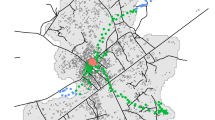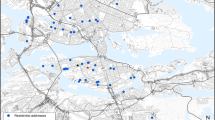Abstract
Indoor air pollution is potentially a very serious environmental and public health problem in India. In poor communities, with the continuing trend in biofuel combustion coupled with deteriorating housing conditions, the problem will remain for some time to come. While to some extent the problem has been studied in rural areas, there is a dearth of reliable data and knowledge about the situation in urban slum areas. The microenvironmental model was used for assessing daily-integrated exposure of infants and women to respirable suspended particulates (RSP) in two slums of Delhi — one in an area of high outdoor pollution and the other in a less polluted area. The study confirmed that indoor concentrations of RSP during cooking in kerosene-using houses are lesser than that in wood-using houses. However, the exposure due to cooking was not significantly different across the two groups. This was because, perhaps due to socioeconomic reasons, kerosene-using women were found to cook for longer durations, cook inside more often, and that infants in such houses stayed in the kitchen for longer durations. It was observed that indoor background levels during the day and at nighttime can be exceedingly high. We speculate that this may have been due to resuspension of dust, infiltration, unknown sources, or a combination of these factors. The outdoor RSP levels measured just outside the houses (near ambient) were not correlated with indoor background levels and were higher than those reported by the ambient air quality monitoring network at the corresponding stations. More importantly, the outdoor levels measured in this study not only underestimated the daily-integrated exposure, but were also poorly correlated with it.
This is a preview of subscription content, access via your institution
Access options
Subscribe to this journal
Receive 6 print issues and online access
$259.00 per year
only $43.17 per issue
Buy this article
- Purchase on Springer Link
- Instant access to full article PDF
Prices may be subject to local taxes which are calculated during checkout



Similar content being viewed by others
Abbreviations
- AM:
-
arithmetic mean
- ANOVA:
-
analysis of variance
- CO:
-
carbon monoxide
- GM:
-
geometric mean
- GSD:
-
geometric standard deviation
- r 2 :
-
correlation coefficient
- RSP:
-
respirable suspended particles
References
Albalak R., Keeler G.J., Frisancho A.R. and Haber M. Assessment of PM10 concentrations from domestic biomass fuel combustion in two rural Bolivian Highland Villages. Environ Sci Technol 1999: 33 (15): 2505–2509.
Benneh G., Songsore J., Nabila J.S., et al. Environmental problems and the urban household in the Greater Accra Metropolitan Area (GAMA) Ghana. Stockholm Environment Institute, Stockholm; 1993, 126pages.
Bruce N., Perez-Padilla R. and Albalak R. Indoor air pollution in developing countries: a major environmental and public health challenge. Bull WHO 2000: 78 (9): 1078–1092.
CPCB. Ambient Air Quality Statistics — 1991. Central Pollution Control Board, New Delhi, 1992.
CPCB. Ambient Air Quality — Status and Statistics: 1995. Central Pollution Control Board, New Delhi, 1997.
Duan N. Microenvironment types: a model for human exposure to air pollution. Environ Int 1982: 8: 305–309.
Ellegard A. Cooking fuel smoke and respiratory symptoms among women in low-income areas in Maputo. Environ Health Perspectives 1996: 104: 980–985.
Ellgard A. and Egneus H. Urban energy: exposure to biomassfuel pollution in Lusaka. Energy Policy 1993: 21 (5): 615–622.
Ezzati M., Saleh H. and Kammen D.M. The contributions of emissions and spatial micro-environments to exposure to indoor air pollution from biomass combustion in Kenya. Environ Health Perspectives 2000: 108 (9): 833–839.
Ju C. and Spengler J.D. Room-to room variations in concentration of respirable particles in residences. Environ Sci Technol 1981: 15 (5): 592–596.
Kandlikar M. and Ramachandran G. The causes and consequences of particulate air pollution in urban India: a synthesis of science. Annu Rev Energy Environ 2000: 25: 629–684.
Kulkarni M.M. Assessment of human exposure to air pollution in a residential cum industrial area of Mumbai. PhD Dissertation, Centre for Environmental Science and Engineering. Indian Institute of Technology, Mumbai, 1998.
Kumar P. Characterization of indoor respirable dust in a locality of Delhi, India. Indoor Built Environ 2001: 10 (2): 95–102.
Malhotra P., Saksena S. and Joshi V. Time budgets of infants for exposure assessment: a methodological study. J Exposure Anal Environ Epidemiol 2000: 10 (3): 267–284.
Menon P. Indoor spatial monitoring of combustion generated pollutants (TSP, CO, BaP) by Indian cookstoves. PhD Thesis, University of Hawaii, Honolulu, 1988.
Raiyani C.V., Shah S.H., Desai N.M., et al. Characterization and problems of indoor pollution due to cooking stove smoke. Atmos Environ 1993: 27A (11): 1643–1656.
Ramakrishna J. Patterns of domestic air pollution in rural India. PhD Thesis, University of Hawaii, Honolulu, 1988.
Sabapathy N. Prediction of indoor outdoor relationship of atmospheric aerosols. Master of Technology Dissertation, Centre for Environmental Science and Engineering. Indian Institute of Technology, Mumbai, 1998.
Sadasivan S., Negi B.S. and Mishra U.C. Composition and sources of aerosols at Trombay, Bombay. Sci Total Environ 1984: 40: 279–286.
Saksena S. Integrated exposure assessment of airborne pollutants in an urban community using biomass and kerosene cooking fuels. PhD Thesis, Centre for Environmental Sciences and Engineering, Indian Institute of Technology, Mumbai, 1999.
Saksena S., Prasad R., Pal R.C. and Joshi V. Patterns of daily exposure to TSP and CO in the Garhwal Himalaya. Atmos Environ 1992: 26A (11): 2125–2134.
Sharma S., Sethi G.R., Rohtagi A., Chaudhary A., Shankar R., Bapna J.S., Joshi V. and Sapir D.G. Indoor air quality and acute lower respiratory infection in Indian urban slums. Environ Health Perspectives 1998: 106 (5): 291–297.
Sharma V.K. and Patil R.S. In situ measurements of atmospheric aerosols in an industrial region of Bombay. J Aerosol Sci 1991: 22 (4): 501–507.
Singh A., Sarin S.M., Shanmugam P., et al. Ozone distribution in the urban environment of Delhi during winter months. Atmos Environ 1997: 31 (2): 3421–3427.
Smith K.R. National burden of disease in India from indoor air pollution. Proc Nat Acad Sci USA 2000: 97 (24): 13286–13293.
Smith K.R., Aggarwal A.L. and Dave R.M. Air pollution and rural biomass fuels in developing countries: a pilot study in India and implications for research and policy. Atmos Environ 1983: 17: 2343–2362.
Smith K.R., Apte M.R., Yuqing M., et al. Air pollution and the energy ladder in Asian cities. Energy 1994; 19 (5): 587–600.
Spengler J.D., Dockery D.W., Turner W.A., et al. Long-term measurements of Respirable Sulfates and particles inside and outside homes. Atmospheric Environment 1981: 15: 23–30.
TERI. Study of the energy needs of slum areas in Delhi. Project Report, Tata Energy Research Institute, New Delhi, 1993.
Tsai F.C., Smith K.R., Vichit-Vadakan N., Ostro B.D., Chestnut L.G. and Kungskulniti N. Indoor/outdoor PM10 and PM2.5 in Bangkok, Thailand. J Exposure Anal Environ Epidemiol 2000: 10 (1): 15–26.
Varshney C.K. and Padhy P.K. Total volatile organic compounds in the urban environment of Delhi. J Air Waste Manage Assoc 1998: 48 (5): 448–453.
Wallace L. Indoor particles: a review. J Air Waste Manage Assoc 1996: 46: 98–126.
WHO. Human exposure to suspended particulate matter and sulfate in Bombay, India. World Health Organization, Geneva, 1984, 36pages.
Zartarian V.G., Ott W.R. and Duan N. A quantitative definition of exposure and related concepts. J Exposure Anal Environ Epidemiol 1997: 7 (4): 411–437.
Acknowledgements
The authors thank Asim Mirza, Milind Saxena, K.K. Srivastava and V.P. Singh for assisting in the field study. We also wish to thank the eighty participating households for their kind cooperation. The study was funded by the European Commission.
Author information
Authors and Affiliations
Corresponding author
Rights and permissions
About this article
Cite this article
Saksena, S., Singh, P., Prasad, R. et al. Exposure of infants to outdoor and indoor air pollution in low-income urban areas — a case study of Delhi. J Expo Sci Environ Epidemiol 13, 219–230 (2003). https://doi.org/10.1038/sj.jea.7500273
Received:
Accepted:
Published:
Issue Date:
DOI: https://doi.org/10.1038/sj.jea.7500273
Keywords
This article is cited by
-
Assessment of indoor air quality and housing, household and health characteristics in densely populated urban slums
Environment, Development and Sustainability (2022)
-
Concentrations of indoor gaseous air pollutants and risk factors associated with childhood asthma in Benin City, Nigeria
Environmental Monitoring and Assessment (2022)
-
Sources of household air pollution and their association with fine particulate matter in low-income urban homes in India
Journal of Exposure Science & Environmental Epidemiology (2018)
-
Biomass smoke in Burkina Faso: what is the relationship between particulate matter, carbon monoxide, and kitchen characteristics?
Environmental Science and Pollution Research (2014)



